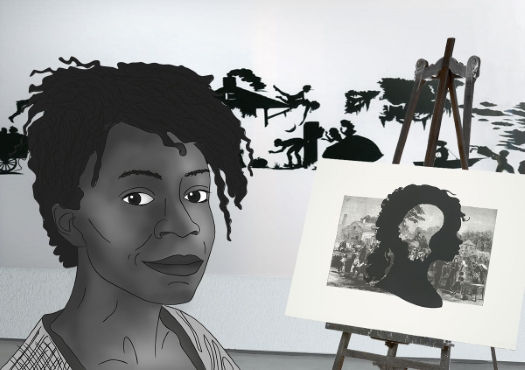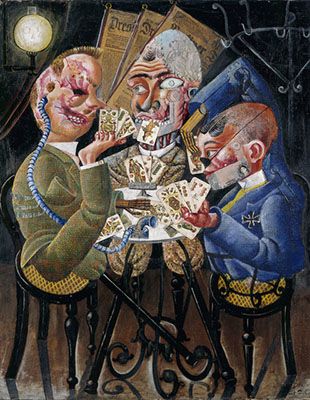Summary of Kara Walker
Fresh out of graduate school, Kara Walker succeeded in shocking the nearly shock-proof art world of the 1990s with her wall-sized cut paper silhouettes. At first, the figures in period costume seem to hearken back to an earlier, simpler time. That is, until we notice the horrifying content: nightmarish vignettes illustrating the history of the American South. Drawing from sources ranging from slave testimonials to historical novels, Kara Walker's work features mammies, pickaninnies, sambos, and other brutal stereotypes in a host of situations that are frequently violent and sexual in nature. Initial audiences condemned her work as obscenely offensive, and the art world was divided about what to do. Was this a step backward or forward for racial politics? Several decades later, Walker continues to make audacious, challenging statements with her art. From her breathtaking and horrifying silhouettes to the enormous crouching sphinx cast in white sugar and displayed in an old sugar factory in Brooklyn, Walker demands that we examine the origins of racial inequality, in ways that transcend black and white.
Accomplishments
- Kara Walker is essentially a history painter (with a strong subversive twist). She almost single-handedly revived the grand tradition of European history painting - creating scenes based on history, literature and the bible, making it new and relevant to the contemporary world. Walker's grand, lengthy, literary titles alert us to her appropriation of this tradition, and to the historical significance of the work.
- Walker's form - the silhouette - is essential to the meaning of her work. It is a potent metaphor for the stereotype, which, as she puts it, also "says a lot with very little information." The silhouette also allows Walker to play tricks with the eye. There is often not enough information to determine what limbs belong to which figures, or which are in front and behind, ambiguities that force us to question what we know and see.
- Walker's images are really about racism in the present, and the vast social and economic inequalities that persist in dividing America. More like riddles than one-liners, these are complex, multi-layered works that reveal their meaning slowly and over time.
- While Walker's work draws heavily on traditions of storytelling, she freely blends fact and fiction, and uses her vivid imagination to complete the picture.
The Life of Kara Walker
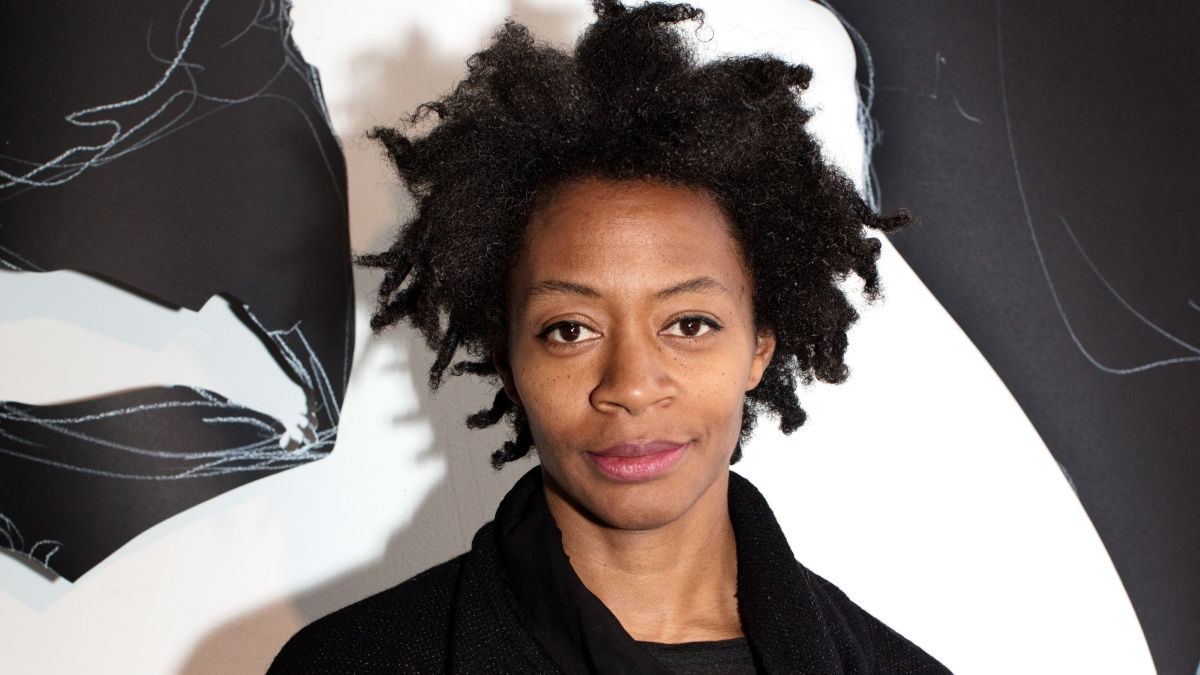
Early in her career Walker was inspired by kitschy flee market wares, the stereotypes these cheap items were based on. Mining such tropes, Walker made powerful and worldly art - she said "I really love to make sweeping historical gestures that are like little illustrations of novels."
Important Art by Kara Walker

Gone: An Historical Romance of a Civil War as it Occurred b'tween the Dusky Thighs of One Young Negress and Her Heart
This extensive wall installation, the artist's first foray into the New York art world, features what would become her signature style. The work's epic title refers to numerous sources, including Margaret Mitchell's Gone with the Wind (1936) set during the Civil War, and a passage in Thomas Dixon, Jr's The Clansman (a foundational Ku Klux Klan text) devoted to the manipulative power of the "tawny negress." The form of the tableau, with its silhouetted figures in 19th-century costume leaning toward one another beneath the moon, alludes to storybook romance. The tableau fails to deliver on this promise when we notice the graphic depictions of sex and violence that appear on close inspection, including a diminutive figure strangling a web-footed bird, a young woman floating away on the water (perhaps the mistress of the gentleman engaged in flirtation at the left) and, at the highest midpoint of the composition, where we can't miss it, underage interracial fellatio.
Silhouetting was an art form considered "feminine" in the 19th century, and it may well have been within reach of female African American artists. Walker uses it to revisit the idea of race, and to highlight the artificiality of that century's practices such as physiognomic theory and phrenology (pseudo-scientific practices of deciphering a person's intelligence level by examining the shape of the face and head) used to support racial inequality as somehow "natural." Walker's black cut-outs against white backgrounds derive their power from the silhouette, a stark form capable of conveying multiple visual and symbolic meanings. Fanciful details, such as the hoop-skirted woman at the far left under whom there are two sets of legs, and the lone figure being carried into the air by an enormous erection, introduce a dimension of the surreal to the image. When asked what she had been thinking about when she made this work, Walker responded, "The history of America is built on this inequality...The gross, brutal manhandling of one group of people, dominant with one kind of skin color and one kind of perception of themselves, versus another group of people with a different kind of skin color and a different social standing. And the assumption would be that, well, times changed and we've moved on. But this is the underlying mythology... And we buy into it. I mean, whiteness is just as artificial a construct as blackness is."
Wall Installation - The Museum of Modern Art, New York

The End of Uncle Tom and the Grand Allegorical Tableau of Eva in Heaven
This and several other works by Walker are displayed in curved spaces. Taking its cue from the cyclorama, a 360-degree view popularized in the 19th century, its form surrounds us, alluding to the inescapable horror of the past - and the cycle of racial inequality that continues to play itself out in history. With its life-sized figures and grand title, this scene evokes history painting (considered the highest art form in the 19th century, and used to commemorate grand events). Loosely inspired by Uncle Tom's Cabin (Harriet Beecher Stowe's famous abolitionist novel of 1852) it surrounds us with a series of horrifying vignettes reenacting the torture, murder and assault on the enslaved population of the American South. These include two women and a child nursing each other, three small children standing around a mistress wielding an axe, a peg-legged gentleman resting his weight on a saber, pinning one child to the ground while sodomizing another, and a man with his pants down linked by a cord (umbilical or fecal) to a fetus.
Walker's use of the silhouette, which depicts everything on the same plane and in one color, introduces an element of formal ambiguity that lends itself to multiple interpretations. For example, is the leg under the peg-legged figure part of the child's body or the man's? What is the substance connecting the two figures on the right? We would need more information to decide what we are looking at, a reductive property of the silhouette that aligns it with the stereotype we may want to question.
Wall installation - The Modern Art Museum of Fort Worth

Untitled (John Brown)
Walker's critical perceptions of the history of race relations are by no means limited to negative stereotypes. Many of her most powerful works of the 1990s target celebrated, indeed sanctified milestones in abolitionist history. Her apparent lack of reverence for these traditional heroes and willingness to revise history as she saw fit disturbed many viewers at the time. Untitled (John Brown), substantially revises a famous moment in the life of abolitionist hero John Brown, a figure sent to the gallows for his role in the raid on Harper's Ferry in 1859, but ultimately celebrated for his enlightened perspective on race. Astonished witnesses accounted that on his way to his own execution, Brown stopped to kiss a black child in the arms of its mother. In a famous lithograph by Currier and Ives, Brown stands heroically at the doorway to the jailhouse, unshackled (a significant historical omission), while the mother and child receive his kiss.
Walker's depiction offers us a different tale, one in which a submissive, half-naked John Brown turns away in apparent pain as an upright, impatient mother thrusts the baby toward him. The child pulls forcefully on his sagging nipple (unable to nourish in a manner comparable to that of the slave women expected to nurse white children). Brown's inability to provide sustenance is a strong metaphor for the insufficiency of opposition to slavery, which did not end. Additionally, the arrangement of Brown with slave mother and child weaves in the insinuation of interracial sexual relations, alluding to the expectation for women to comply with their masters' advances. By casting heroic figures like John Brown in a critical light, and creating imagery that contrasts sharply with the traditional mythology surrounding this encounter, the artist is asking us to reexamine whether we think they are worthy of heroic status.
Sepia gouache - Brooklyn Museum

No mere words can Adequately reflect the Remorse this Negress feels at having been Cast into such a lowly state by her former Masters and so it is with a Humble heart that she brings about their physical Ruin and earthly Demise
"I wanted to make a piece that was incredibly sad," Walker stated in an interview regarding this work. "I wanted to make a piece that was about something that couldn't be stated or couldn't be seen." Against a dark background, white swans emerge, glowing against the black backdrop. As our eyes adjust to the light, it becomes apparent that there are black silhouettes of human heads attached to the swans' necks. Flanking the swans are three blind figures, one of whom is removing her eyes, and on the right, a figure raising her arm in a gesture of triumph that recalls the figure of liberty in Delacroix's Lady Liberty Leading the People. The procession is enigmatic and, like other tableaus by Walker, leaves the interpretation up to the viewer. Like other works by Walker in the 1990s, this received mixed reviews. Some critics found it brave, while others found it offensive. While her work is by no means universally appreciated, in retrospect it is easier to see that her intention was to advance the conversation about race.
Wall installation - San Francisco Museum of Modern Art

Darkytown Rebellion
Having made a name for herself with cut-out silhouettes, in the early 2000s Walker began to experiment with light-based work. In Darkytown Rebellion, in addition to the silhouetted figures (over a dozen) pasted onto 37 feet of a corner gallery wall, Walker projected colored light onto the ceiling, walls, and floor. The effect creates an additional experiential, even psychedelic dimension to the work. Shadows of visitor's bodies - also silhouettes - appear on the same surfaces, intermingling with Walker's cast. With their human scale, her installation implicates the viewer, and color, as opposed to black and white, links it to the present. Our shadows mingle with the silhouettes of fictitious stereotypes, inviting us to compare the two and challenging us to decide where our own lives fit in the progression of history.
Cut paper and projection on wall - Musée d'Art Moderne Grand-Duc Jean, Luxembourg

A Subtlety, or the Marvelous Sugar Baby an Homage to the unpaid and overworked Artisans who have refined our Sweet tastes from the cane fields to the Kitchens of the New World on the Occasion of the demolition of the Domino Sugar Refining Plant
This work, Walker's largest and most ambitious work to date, was commissioned by the public arts organization Creative Time, and displayed in what was once the largest sugar refinery in the world. The monumental form, coated in white sugar and on view at the defunct Domino Sugar plant in Williamsburg, Brooklyn, evoked the racist stereotype of "mammy" (nurturer of white families), with protruding genitals that hyper-sexualize the sphinx-like figure. Attending her were sculptures of young black boys, made of molasses and resin that melted away in the summer heat over the course of the exhibition. Sugar in the raw is brown. White sugar, a later invention, was bleached by slaves until the 19th century in greater and greater quantities to satisfy the Western appetite for rum and confections. Sugar cane was fed manually to the mills, a dangerous process that resulted in the loss of limbs and lives. This site-specific work, rich with historical significance, calls our attention to the geo-political circumstances that produced, and continue to perpetuate, social, economic, and racial inequity. A powerful gesture commemorating undocumented experiences of oppression, it also called attention to the changing demographics of a historically industrial and once working-class neighborhood, now being filled with upscale apartments. Sugar Sphinx shares an air of mystery with Walker's silhouettes.
Installation - Domino Sugar Plant, Williamsburg, Brooklyn
Biography of Kara Walker
Childhood
A painter's daughter, Walker was born into a family of academics in Stockton, California in 1969, and grew interested in becoming an artist as early as age three. When her father accepted a position at Georgia State University, she moved with her parents to Stone Mountain, Georgia, at the age of 13. In sharp contrast with the widespread multi-cultural environment Walker had enjoyed in coastal California, Stone Mountain still held Klu Klux Klan rallies. At her new high school, Walker recalls, "I was called a 'nigger,' told I looked like a monkey, accused (I didn't know it was an accusation) of being a 'Yankee.'" Walker felt unwelcome, isolated, and expected to conform to a stereotype in a culture that did not seem to fit her. She escaped into the library and into books, where illustrated narratives of the South helped guide her to a better understanding of the customs and traditions of her new environment.
Early Training and Career
Walker attended the Atlanta College of Art with an interest in painting and printmaking, and in response to pressure and expectation from her instructors (a double standard often leveled at minority art students), Walker focused on race-specific issues. She then attended graduate school at the Rhode Island School of Design, where her work expanded to include sexual as well as racial themes based on portrayals of African Americans in art, literature, and historical narratives. Walker, an expert researcher, began to draw on a diverse array of sources from the portrait to the pornographic novel that have continued to shape her work. Other artists who addressed racial stereotypes were also important role models for the emerging artist. While still in graduate school, Walker alighted on an old form that would become the basis for her strongest early work. Widespread in Victorian middle-class portraiture and illustration, cut paper silhouettes possessed a streamlined elegance that, as Walker put it, "simplified the frenzy I was working myself into."
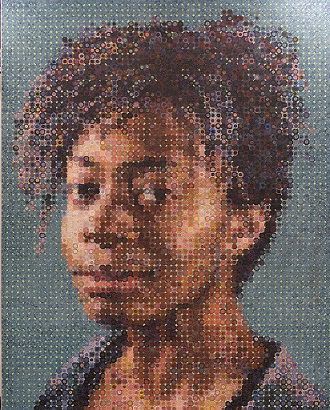
Walker's first installation bore the epic title Gone: An Historical Romance of a Civil War as It Occurred Between the Dusky Thighs of One Young Negress and Her Heart (1994), and was a critical success that led to representation with a major gallery, Wooster Gardens (now Sikkema Jenkins & Co.). A series of subsequent solo exhibitions solidified her success, and in 1998 she received the MacArthur Foundation Achievement Award. Despite a steady stream of success and accolades, Walker faced considerable opposition to her use of the racial stereotype. Among the most outspoken critics of Walker's work was Betye Saar, the artist famous for arming Aunt Jemima with a rifle in The Liberation of Aunt Jemima (1972), one of the most effective, iconic uses of racial stereotype in 20th-century art. Nonetheless, Saar insisted Walker had gone too far, and spearheaded a campaign questioning Walker's employment of racist images in an open letter to the art world asking: "Are African Americans being betrayed under the guise of art?" Walker's series of watercolors entitled Negress Notes (Brown Follies, 1996-97) was sharply criticized in a slew of negative reviews objecting to the brutal and sexually graphic content of her images. Saar and other critics expressed concern that the work did little more than perpetuate negative stereotypes, setting the clock back on representations of race in America. Others defended her, applauding Walker's willingness to expose the ridiculousness of these stereotypes, "turning them upside down, spread-eagle and inside out" as political activist and Conceptual artist Barbara Kruger put it.
Mature Period
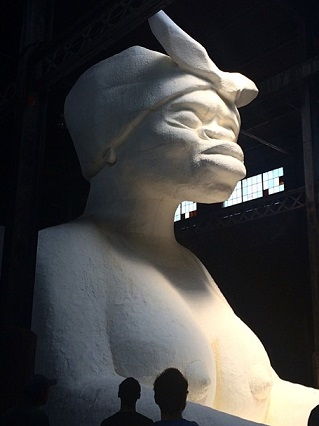
Walker, still in mid-career, continues to work steadily. Despite ongoing star status since her twenties, she has kept a low profile. In 1996 she married (and subsequently divorced) German-born jewelry designer and RISD professor Klaus Burgel, with whom she had a daughter, Octavia. Interviews with Walker over the years reveal the care and exacting precision with which she plans each project. They also radiate a personal warmth and wit one wouldn't necessarily expect, given the weighty content of her work. When an interviewer asked her in 2007 if she had had any experience with children seeing her work, Walker responded "just my daughter... she did at age four say something along the lines of 'Mommy makes mean art.'"
Recent projects include light and projection-based installations that integrate the viewer's shadow into the image, making it a dynamic part of the work. Walker's most ambitious project to date was a large sculptural installation on view for several months at the former Domino Sugar Factory in the summer of 2014. As a Professor at Columbia University (2001-2015) and subsequently as Chair of the Visual Arts program at Rutgers University, Walker has been a dedicated mentor to emerging artists, encouraging her students "to live with contentious images and objectionable ideas, particularly in the space of art."
The Legacy of Kara Walker
Fierce initial resistance to Walker's work stimulated greater awareness of the artist, and pushed conversations about racism in visual culture forward. In 1998 (the same year that Walker was the youngest recipient ever of the MacArthur "genius" award) a two-day symposium was held at Harvard, addressing racist stereotypes in art and visual culture, and featuring Walker (absent) as a negative example. Rising above the storm of criticism, Walker always insisted that her job was to jolt viewers out of their comfort zone, and even make them angry, once remarking "I make art for anyone who's forgot what it feels like to put up a fight." In 2007, TIME magazine featured Walker on its list of the 100 most influential Americans. In 2008 when the artist was still in her thirties, The Whitney held a retrospective of Walker's work. Though Walker herself is still in mid-career, her illustrious example has emboldened a generation of slightly younger artists - Wangechi Mutu, Kehinde Wiley, Hank Willis-Thomas, and Clifford Owens are among the most successful - to investigate the persistence and complexity of racial stereotyping.
Influences and Connections

![Clifford Owens]() Clifford Owens
Clifford Owens![Wangechi Mutu]() Wangechi Mutu
Wangechi Mutu
![Mickalene Thomas]() Mickalene Thomas
Mickalene Thomas
Useful Resources on Kara Walker
- Kara Walker: Narratives of a NegressBy Berry, Ian, Darby English, Vivian Patterson and Mark Reinhardt
- Seeing the Unspeakable: The Art of Kara WalkerOur PickBy Shaw, Gwendolyn DuBois
- Kara Walker: My Complement, My Enemy, My Oppressor, My LoveOur PickBy Kara Walker, Philippe Vergne, and Sander Gilman
- Kara Walker: After the DelugeBy Kara Walker
- Kara Walker: Bureau of RefugeesBy Kara Walker
- Kara Walker - MCMXCIXBy Kara Walker
- Kara Walker: Dust Jackets for the NiggeratiBy Hilton Als, James Hannaham and Christopher Stackhouse
- Kara Walker: A Black Hole Is Everything a Star Longs to BeOur PickBy Anita Heldemann
- Consuming Stories: Kara Walker and the Imagining of American RaceOur PickBy Rebecca Peabody
- The Ecstasy of St. Kara: Kara Walker, New WorkBy Reto Thüring, Beau Rutland, Kara Walker John Lansdowne, and Tracy K. Smith
- Kara Walker: Hyundai CommissionBy Clara Kim
- Odes to Blackness: Gender Representation in the Art of Jean-Michel Basquiat and Kara WalkerBy Iryna Fedorchak
 Ask The Art Story AI
Ask The Art Story AI